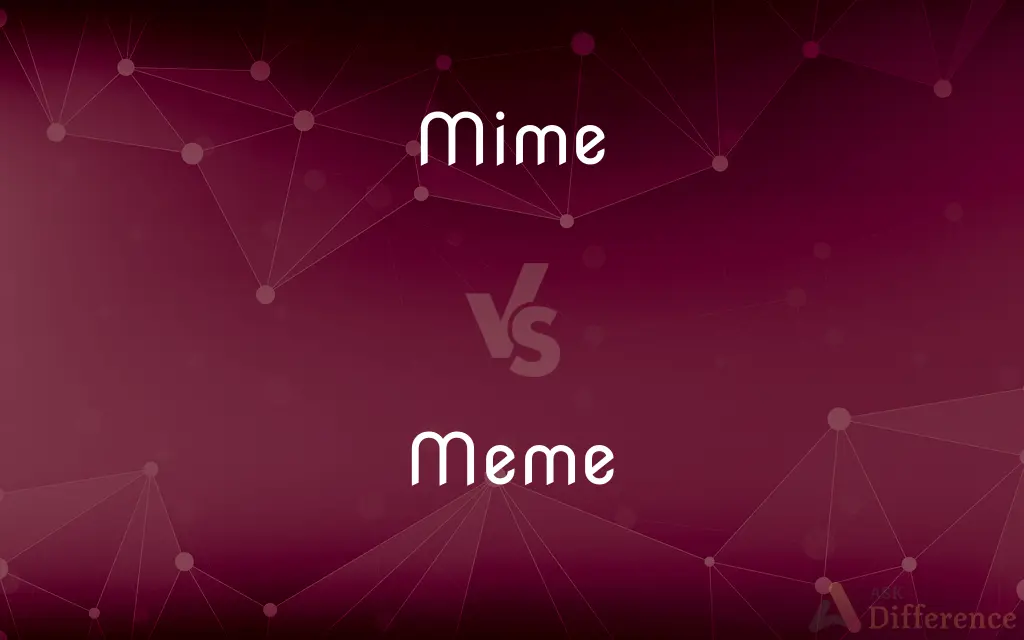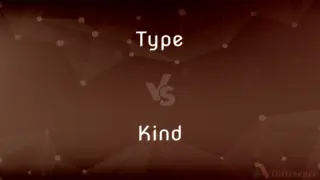Mime vs. Meme — What's the Difference?
By Fiza Rafique & Maham Liaqat — Updated on February 26, 2024
Mime is a form of silent art that expresses ideas through gestures and facial expressions, while a meme is a cultural symbol or social idea spread via the internet.

Difference Between Mime and Meme
Table of Contents
ADVERTISEMENT
Key Differences
Mime, an art form rooted in theatrical traditions, relies on body movements, gestures, and facial expressions to convey stories or emotions without spoken words. Memes, in contrast, are units of cultural information that spread virally across the internet. They can be images, videos, texts, or even just concepts that encapsulate humor, ideas, or themes relatable to a wide audience.
Mime is a performance art that emphasizes physical expression and often involves mimicking actions or scenarios in an exaggerated manner. Memes evolve through sharing, imitation, and variation, reflecting the cultural zeitgeist.
Mime is a centuries-old practice with origins in ancient Greece and popularized in modern times by artists like Marcel Marceau, memes are a product of the digital age, gaining prominence with the rise of social media and online communities. Both forms communicate ideas, but they do so through vastly different mediums and to different effects.
Mime requires physical presence and skill, often performed live to an audience, making it a direct and personal form of art. Memes, however, thrive on digital platforms, reaching a global audience instantly and evolving rapidly as they are reshaped and reinterpreted by users.
Comparison Chart
Medium
Physical performance
Digital content
ADVERTISEMENT
Communication
Non-verbal, using gestures and expressions
Primarily visual or textual, often humorous
Origin
Ancient Greece
Internet era
Purpose
To tell a story or express emotion without words
To spread cultural ideas or jokes rapidly online
Audience
Live audiences
Global internet users
Compare with Definitions
Mime
A silent art of storytelling through gestures and facial expressions.
The mime artist captivated the audience without uttering a single word.
Meme
Digital content that captures relatable life truths.
I find memes about work life surprisingly accurate.
Mime
Theatrical tradition emphasizing body movement.
Mime has its roots in ancient theatrical practices.
Meme
An idea or joke that spreads through the internet.
The latest political meme has sparked a lot of discussions online.
Mime
Physical comedy or drama without speech.
The street performer's mime show drew a large crowd.
Meme
Unit of cultural information shared across social media.
Memes can often communicate complex ideas succinctly.
Mime
Art of expressing ideas silently.
Mime requires precise control over one's movements and expressions.
Meme
A viral piece of culture, typically humorous, spread online.
That meme about cats was shared millions of times.
Mime
Performance art focusing on non-verbal communication.
He studied mime to improve his expressive abilities.
Meme
A way for internet communities to share common experiences.
This meme perfectly sums up our fandom.
Mime
The art of portraying characters and acting out situations or a narrative by gestures and body movement without the use of words; pantomime.
Meme
A meme ( MEEM) is an idea, behavior, or style that spreads by means of imitation from person to person within a culture and often carries symbolic meaning representing a particular phenomenon or theme. A meme acts as a unit for carrying cultural ideas, symbols, or practices, that can be transmitted from one mind to another through writing, speech, gestures, rituals, or other imitable phenomena with a mimicked theme.
Mime
To represent an action or object through gesture, without the use of sound.
In this game, you're given a word, which you have to mime to the others in the group.
Meme
To joke around.
Mime
An actor who communicates entirely by gesture and facial expression
Mime
A performance using gestures and body movements without words
Mime
Act out without words but with gestures and bodily movements only;
The acting students mimed eating an apple
Common Curiosities
What is mime?
Mime is a form of silent art that uses gestures and facial expressions to convey stories or emotions without spoken words.
What is a meme?
A meme is a piece of content or an idea that spreads virally online, often embodying humorous or cultural themes.
How do mime and meme differ in communication?
Mime uses physical expression in a live performance, while memes use digital media to convey ideas humorously or insightfully.
Can memes be considered a form of art like mime?
Yes, memes can be considered a form of digital art as they involve creativity and expression, reflecting societal and cultural trends.
How has the role of mime changed with the advent of the internet?
While mime remains a respected performance art, its visibility and mode of dissemination have expanded through online platforms, albeit not as significantly as memes.
Why are memes important in modern culture?
Memes play a significant role in shaping and reflecting public opinion, humor, and cultural trends, making them an integral part of digital communication.
What skills are required for mime?
Mime requires physical agility, expressiveness, and the ability to convey complex narratives without words.
Can a mime performance be turned into a meme?
Yes, a mime performance can be captured in a photo or video and shared online as a meme, blending traditional art with digital culture.
Is mime still relevant today?
Yes, mime continues to be a valued art form for its unique ability to communicate universally, transcending language barriers.
Can mime be considered a universal language?
Yes, mime can be considered a universal language as it communicates through actions and expressions, understandable to any audience regardless of linguistic background.
How do memes reflect society?
Memes often capture and parody societal norms, issues, and trends, serving as a mirror to contemporary culture.
How do audiences interact with mime and memes differently?
Mime audiences engage through live observation and appreciation, while meme audiences interact through sharing, commenting, and remixing online.
What makes a meme successful?
A successful meme resonates with a wide audience, often through humor, relatability, or sharp commentary on current events.
What role do memes and mime play in communication?
Both mime and memes enrich communication by adding layers of meaning, emotion, and humor, albeit in vastly different contexts and mediums.
How do memes spread?
Memes spread through social media, forums, and various online platforms, gaining traction through shares, likes, and modifications by users.
Share Your Discovery

Previous Comparison
Sciency vs. Sciencey
Next Comparison
Type vs. KindAuthor Spotlight
Written by
Fiza RafiqueFiza Rafique is a skilled content writer at AskDifference.com, where she meticulously refines and enhances written pieces. Drawing from her vast editorial expertise, Fiza ensures clarity, accuracy, and precision in every article. Passionate about language, she continually seeks to elevate the quality of content for readers worldwide.
Co-written by
Maham Liaqat













































